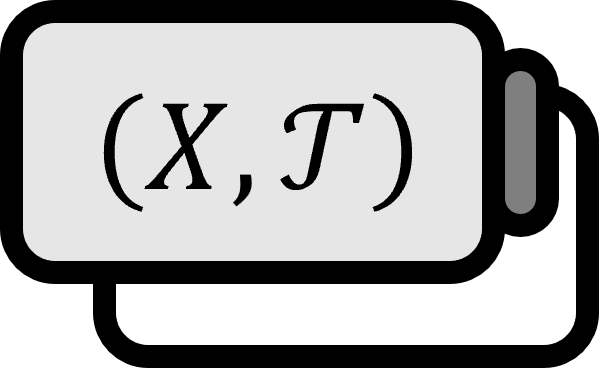Continuous in Topology
Definition
For a topological space $(X, \mathscr{T}_{X} )$ and $(Y, \mathscr{T}_{Y} )$, let’s denote by $f: X \to Y$. A function $f$ is said to be continuous at $a$ if, for every neighborhood $V \in \mathscr{T}_{Y}$ containing $f(a)$, there exists a neighborhood $U \in \mathscr{T}_{X}$ containing $a$ such that $f(U) \subset V$ is satisfied. If $f$ is continuous at every point of $X$, it is called a continuous function and can be represented as $f \in C(X,Y)$.
Explanation
At first glance, this definition might seem difficult to grasp, but upon closer examination, it is essentially the same concept as defining continuity in analysis, where for every given $\epsilon > 0$, there exists an $\delta$ satisfying $\left| x - a \right| \lt \delta \implies \left| f(x) - f(a) \right| \lt \epsilon$. Noting that $\left\{ x : \left| x - a \right| \lt \delta \right\}$ and $\left\{ f(x) : \left| f(x) - f(a) \right| \lt \epsilon \right\}$ are open sets, the idea that for every given $\epsilon$, an $\delta$ can be found translates to being able to find an open set satisfying the condition in $X$ for every open set given in $Y$.
It’s worth noting that $C(X,Y)$ represents the set of continuous functions with domain $X$ and codomain $Y$. For those studying topology, the epsilon-delta argument is probably well-tread territory, making formulas and symbols more comfortable than text.
Continuity has been generalized from the Euclidean space to metric spaces, and now beyond metric spaces to topological spaces. If the discussion of continuity in analysis is primarily for the sake of differentiation, in topology, the concept of continuity is necessary to discuss homeomorphisms.
Below are various equivalent conditions for continuous points and continuous functions. Since these are equivalent conditions, they can sometimes be used as definitions depending on the textbook.
Equivalent Conditions for Continuous Points
If we denote by $a \in X$, the following propositions are equivalent:
- (1): $f : X \to Y$ is continuous at $a$.
- (2): For every neighborhood $V \in \mathscr{T}_{Y}$ containing $f(a)$, there exists a neighborhood $ U \in \mathscr{T}_{X}$ satisfying $a \in U \subset f^{-1} (V)$.
- (3): For every $\mathcal{N} ( f(a) )$, $f^{-1} ( \mathcal{N} ( f(a) ) )$ is a neighborhood of $a$.
- (4): For all $V \subset Y$ satisfying $f(a) \in V^{\circ}$, $a \in (f^{-1} (V))^{\circ} $ holds.
It’s worth mentioning that $\mathcal{N} (a)$ is an open set in $X$ containing $a$, known as the neighborhood of $a$.
Equivalent Conditions for Continuous Functions
The following propositions are equivalent:
- [1]: $f : X \to Y$ is a continuous function.
- [2]: For every neighborhood $V \in \mathscr{T}_{Y}$ containing $f(a)$ and every point $a \in f^{-1} (V)$, there exists a neighborhood $ U_{a} \in \mathscr{T}_{X}$ satisfying $a \in U_{a} \subset f^{-1} (V)$.
- [3]: For every open set $V \subset Y$, $f^{-1} (V)$ is an open set in $X$1.
- [4]: For every closed set $C \subset Y$, $f^{-1} (C)$ is a closed set in $X$.
- [5]: For every $A \subset X$, $f( \overline{A} ) \subset \overline{ f(A) } $ holds.
- [6]: For every $B \in \mathscr{B}$, there exists a basis $\mathscr{B}$ of $\mathscr{T}_{Y}$ satisfying $f^{-1} (B) \in \mathscr{T}_{X}$.
- [7]: For every $S \in \mathscr{S}$, there exists a sub-basis $\mathscr{S}$ of $\mathscr{T}_{Y}$ satisfying $f^{-1} (S) \in \mathscr{T}_{X}$.
- [8]: Composition of continuous functions: If $f : X \to Y$ and $g : Y \to Z$ are continuous functions, then the composite function $g \circ f : X \to Z$ is also continuous.
Another Definition of Continuous Functions
Especially, ‘Theorem [3]: For every open set $V \subset Y$, $f^{-1} (V)$ is an open set in $X$’ is frequently used and often serves as the definition of continuous functions. While it’s not necessary to memorize all listed conditions, it’s crucial to remember [3] and be able to apply it readily.
Munkres. (2000). Topology(2nd Edition): p102. ↩︎
